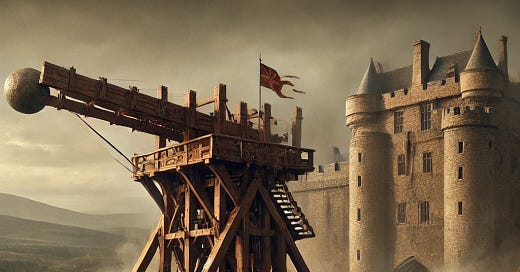Medieval warfare was a brutal contest of strength, strategy, and siegecraft. Castles were the ultimate strongholds, designed to withstand long and relentless attacks. But in 1303, during Edward I of England’s campaign to subdue Scotland, one weapon stood above all others in sheer destructive power and intimidation—the War Wolf, the most feared trebuchet of its time.
Constructed to break the defenses of Brechin Castle, the War Wolf was more than just a siege engine; it was a symbol of English dominance, designed to crush resistance both physically and psychologically. But was it truly the largest trebuchet ever built, or is its legend exaggerated? Let’s uncover the truth behind Edward I’s deadliest war machine.
The Trebuchet: Medieval Artillery at Its Peak
Before diving into the War Wolf, it’s essential to understand the trebuchet, one of the most advanced siege engines of the medieval world.
How It Worked: The trebuchet operated using a counterweight system. A massive stone was placed in a sling attached to a long wooden arm. When released, the counterweight’s force launched the stone with immense velocity, capable of smashing through castle walls.
Why It Was Deadly: Unlike battering rams, which required soldiers to be dangerously close to enemy walls, trebuchets allowed attackers to strike from a safe distance. They could also hurl dead animals, fireballs, and even diseased corpses to weaken defenders before an assault.
The trebuchet was the medieval equivalent of heavy artillery—powerful, terrifying, and highly effective.
The War Wolf: Edward I’s Ultimate Weapon
Edward I, known as "Hammer of the Scots," was determined to crush Scottish resistance. In 1303, he laid siege to Stirling Castle, one of the most strategically important fortresses in Scotland. But the Scots proved resilient, forcing Edward to deploy a secret weapon—the War Wolf, a custom-built super trebuchet.
What Made the War Wolf Special?
It Was Huge – Some sources claim the War Wolf was the largest trebuchet ever built, requiring a massive crew to operate it. Its exact dimensions remain unknown, but accounts suggest it could launch 300-pound stones over long distances.
It Took Months to Assemble – Unlike smaller trebuchets, which could be built on-site in a few weeks, the War Wolf was a monumental engineering feat.
It Was More Than Just a Weapon – The War Wolf was designed not just to destroy walls but to break morale. Its mere presence was enough to convince defenders that resistance was futile.
The War Wolf at the Siege of Stirling (1304)
The most famous use of the War Wolf was during the siege of Stirling Castle in 1304. By this time, most Scottish resistance had crumbled, but the garrison at Stirling Castle continued to hold out.
Edward’s Command: Build the Ultimate Siege Engine
Edward ordered his best engineers and craftsmen to construct a trebuchet powerful enough to ensure that no castle could withstand him again. He brought in materials and carpenters from all over England, constructing the War Wolf piece by piece.
The Scots Surrender Too Soon
Before the War Wolf could even be used, the Scottish defenders offered to surrender, realizing they were doomed. However, Edward refused to accept their surrender—he had spent too much time and money on this machine. He wanted to see it in action.
The War Wolf’s Destruction
Edward ordered his men to fire the War Wolf anyway, despite the Scots already having surrendered. The trebuchet unleashed destruction on the castle walls, obliterating sections of the fortress and leaving no doubt about its power.
The message was clear: resist Edward, and you will be destroyed.
How Did the War Wolf Compare to Other Trebuchets?
The War Wolf was impressive, but was it truly the largest trebuchet ever built?
Other Notable Trebuchets in History:
Malvoisin (Evil Neighbor) – Used by Richard the Lionheart in 1191 at the siege of Acre.
Louise Bourgeois – A French trebuchet used during the Hundred Years’ War.
The Ottoman Bombard – While technically not a trebuchet, the Ottomans built enormous cannons that replaced these siege weapons in the 15th century.
The War Wolf may not have been the biggest in history, but it was undoubtedly one of the most famous, thanks to Edward’s strategic use of it as both a weapon of war and propaganda.
What Happened to the War Wolf?
After the siege of Stirling, the War Wolf disappears from history. Unlike castles and documents, wooden siege engines did not survive for long. However, its legend lived on:
Some believe it was dismantled and used in future sieges.
Others suggest Edward had it burned to prevent it from falling into enemy hands.
No physical remains of the War Wolf have ever been found, but its story continues to be told.
Conclusion: A Legacy of Fear and Power
The War Wolf was not just a trebuchet—it was a psychological weapon. By building an enormous war machine and refusing to accept surrender until it was fired, Edward I sent a clear message to Scotland: resistance was futile.
While other siege weapons may have been larger or more advanced, few have matched the War Wolf’s legendary status. It remains one of the most infamous weapons of medieval warfare, a testament to Edward I’s ambition, brutality, and military ingenuity.
Would Scotland have resisted longer if not for the War Wolf? We may never know, but one thing is certain: no castle was safe from the Hammer of the Scots and his monstrous siege engine.





